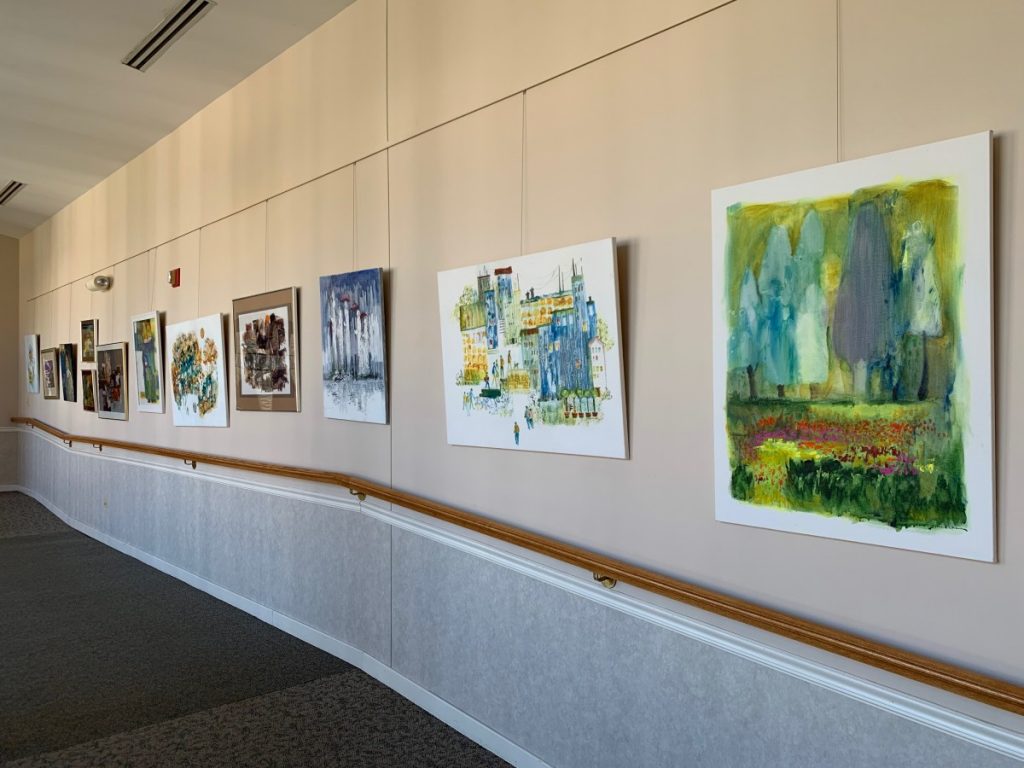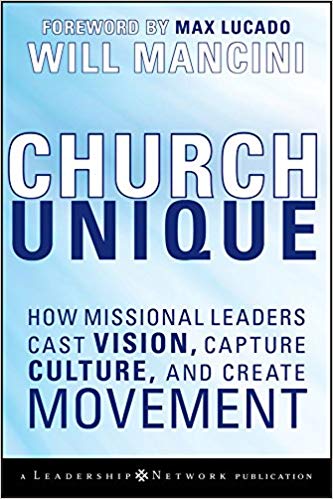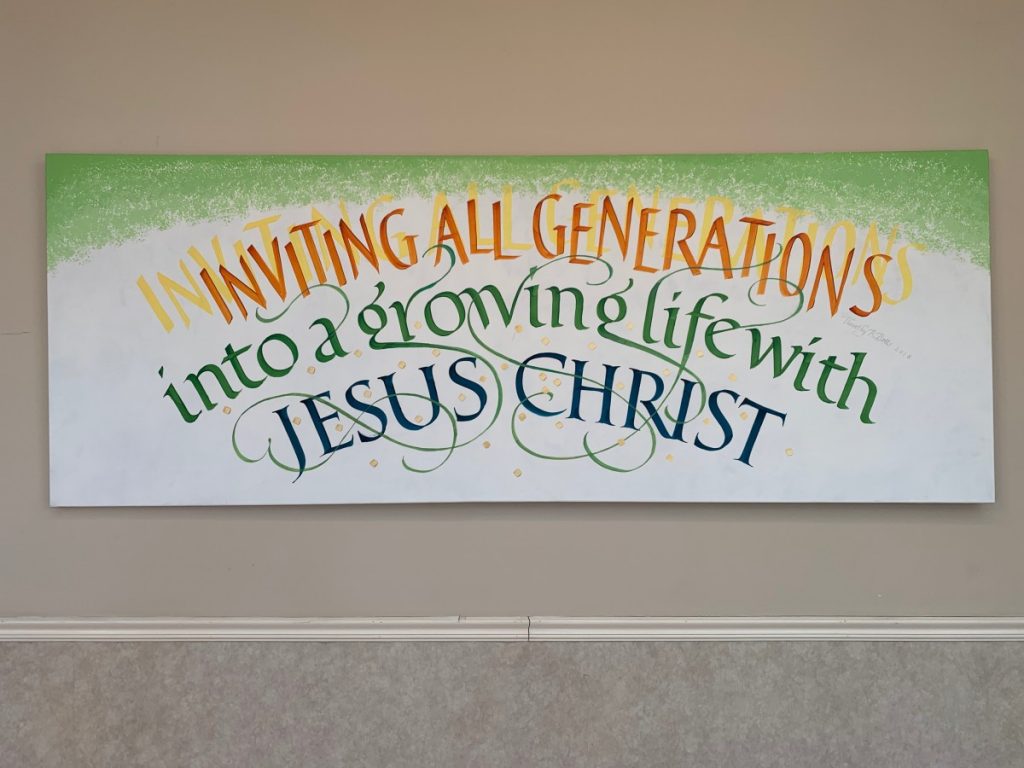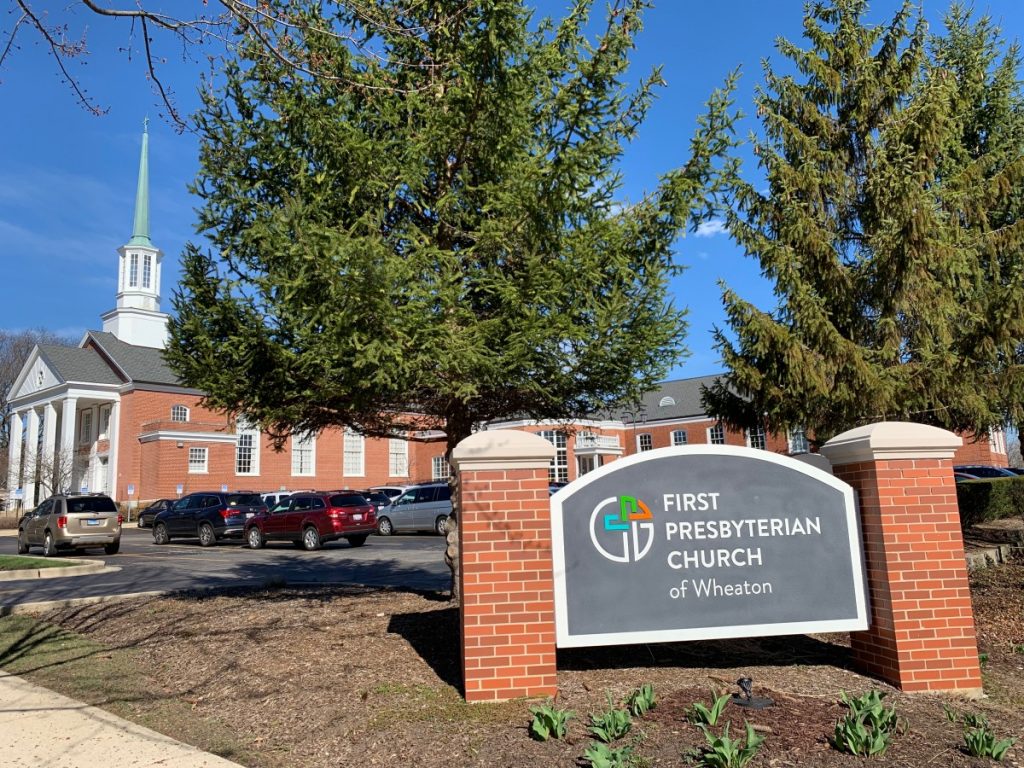Project Introduction
In the summer of 2017, I began my ministry as the Senior Pastor at First Presbyterian Church of Wheaton. One of my initial tasks was to sit down and have one-on-one conversations with the staff and elders of the church. In the list of several questions for discussion, I included what I felt to be the key question:
“What is the vision of the church?”
Out of the thirty conversations I had, only one person mentioned the words of the vision that were on the church website at that time: “Together, we celebrate, journey, and serve.” In the end, there were thirty different answers to my question. Notably, more than half of those I spoke with said the church did not actually have a vision. My conclusion was this: I was serving a vision-starved congregation. The Old King James translation of Proverbs 29:18 sums up the situation: “Where there is no vision, the people perish.”
Within the next year, we began a journey that would culminate in a new vision for the church. This project tells the story of that process, documents the strategic visioning work that was accomplished, and identifies some of the initial results. In particular, I will reflect on the role of preaching in the process and its function as the primary vision casting method. My thesis for this project is:
Preaching the church’s unique vision is the catalyst for the church’s peak growth.
The Presenting Problem
From the year 2000 to 2015, First Presbyterian Church of Wheaton was on a slow, but steady decline. In that time span, overall worship attendance decreased by 54%, from an average Sunday morning attendance of over 700 in the year 2000 to below 300 in 2015. Not only had numerical growth stopped, but it severely declined over time as indicated by the decrease in attendance. What made the decline so difficult to remedy, is that it happened over many years. It was not a sudden decrease that caused immediate concern.
Over those years, the church had lost what researcher Carol Dweck calls a growth mindset, a perspective which previously enabled it to grow and thrive. In years past, the pastor went door to door explaining that the church was growing and building programs for families. Additionally, the church had a developed a system of committees where a growth mindset was ingrained and there was responsibility within each ministry team to support the expansion of the church. Dweck describes the growth mindset by explaining, “The view you adopt for yourself profoundly affects the way you live your life.”[1] Each leader within the church went through training to ensure they were prepared to lead with a growth mindset. Eventually, the training was abandoned as the emphasis shifted to other ministries. While Dweck describes a growth mindset on a personal level, during years of decline the mindset of the organization, in this case, had shifted from a growth to a fixed perspective. Financial resources and volunteers became increasingly limited. A decision was made to eliminate one of three pastoral positions and giving for mission was decreased. The viewpoint was that of managing decline. Rather than seeing growth in attendance as possible, a fixed perspective of decline permeated the church.
About four years earlier, the previous pastor had attempted to initiate a visioning process. That pastor stayed at the church only about a year following the release of the vision, but was present for the initial rollout. In reviewing the previous work that had been done, and in light of the significance of preaching in the Presbyterian tradition, I asked one crucial question from my perspective:
Was the vision ever preached?
The plain answer was: no. In fact, there was not much strategy around the vision being passed on to the congregation. One day, the words “together we celebrate, journey and serve” suddenly appeared on the church website and in the bulletin. The church had missed a vision handoff opportunity or time to celebrate the new vision. Therefore, the vision never took hold. Without ever being preached, the church never developed a vision vocabulary. What I mean by this is how the members of the church might speak about what the church is doing and why it is going about it, speaking a common language of vision. While preaching is not the only method by which a vision is cast, in a church context it can be the primary method. By not affirming the vision from the pulpit, a key element was missing. Without a Great Commission moment, there was no rallying cry or direction for where the church was going or what it was supposed to be doing.
Influences for Preaching, Vision, and Growth
The theological and biblical underpinning for this project and visioning process is found in Acts chapter 2. Breaking down Acts 2 into three sections provides a similar outline that shapes my theology of the preaching, the vision, and the growth that would follow. The theology and practice of Acts 2 provided an important guide as I envisioned the structure and outcome of this project as influenced by the three main sections of Acts 2: Peter’s sermon (Acts 2:14-41) witnessing to the vision God was providing on the day of Pentecost (Acts 2:1-13) and the people’s response through the growth of community (Acts 2:42-47).
Peter was a witness to God’s word and work. It is the idea of proclaiming and witness that captures the essence of preaching. In his landmark preaching textbook, The Witness of Preaching, Tom Long explains, “The move from text to sermon is a move from beholding to attesting, from seeing to saying, from listening to telling, from perceiving to testifying, from being a witness to bearing witness.”[2] Long’s concept of bearing witness informs what I believe to be the role of preaching in the community. Like Peter and all the preachers that have followed, those who respond to God’s word are witnessing to the people about God’s vision for them. Ultimately, the strength of preaching is witnessing to a greater reality.
When asked about what was being done at the church in my first year, I would often say: we are discovering the vision that God has placed before us, a vision that has been present since the founding of the church. For the vision to ultimately take hold, it would need to come from and be accessible to the people, much like the power of the words on the day of Pentecost. Part of this accessibility is that the vision would be unique, particular to our congregation. As part of my thesis, the desire for a unique vision was inspired by what the early church experienced in the special revelation of the Holy Spirit’s vision on Pentecost. In a variety of formats, we would ask the questions: What direction is God leading us? What distinct vision has God given us? What makes our church unique? As God’s vision is revealed for us, we would choose a blueprint for how to tell the story of the vision for the congregation. While it may not be as dramatic as the Pentecost experience, we trusted that God would speak and the Holy Spirit would give language to our vision in a way we would each understand.
Beyond Acts 2, the most significant influence on my theology of vision and the primary resource utilized for the visioning process was a book called Church Unique: How Missional Leaders Cast Vision, Capture Culture, and Create Movement, by Will Mancini, who calls himself a clarity evangelist. Mancini is a pastor turned church consultant and his company Auxano helps churches discover their unique identity through a visioning process. About uniqueness, Mancini says, “The starting point for vision—for thinking about our church’s future—is not deciding where we want to go or exploring what is working for other churches but understanding how we are unique.”[3] In contrast to the copycat method approach that many church conferences and consultants offer, the Church Unique approach includes discovering the distinct heartbeat within each congregation and making that the focus of the vision. In the vision work of years prior, there was also no blueprint or method by which a vision would be articulated, nor was much thought put into it being unique to the DNA of the church itself.
The Visioning Process
We also organized a series of fellowship gatherings called Community Dinners. People throughout the church were invited to dinners where they could meet the pastor and share a sense of community together. We held 10 dinners in total, ranging from 8-20 people each time. These informal settings were ideal situations to begin vision conversations. Once the community dinners concluded, plans were made for a congregational survey. The survey was comprised of 34 questions, designed to assess the current ministries and probe the identity of the church for use in the visioning process. After the survey, vision retreats were held for both the staff and elders. From each retreat, there were input lists from each group that would help inform the first formal step of the visioning process.
Following the retreats, I assembled an eight-person vision team to begin the work of refining the results of the congregational survey and vision retreats as well as articulating the vision itself. The team included both staff and church members. Using the Church Unique blueprint, the team met weekly over five months to create a vision frame. Each aspect of the vision frame took several weeks to refine. The articulation of the vision took place during silent reflection, whiteboard sessions, and individual drafts of statements and concepts. Inevitably, when a new phrase or idea was shared, the vision team was able to strengthen it collectively. The group processing aspect of the work brought greater clarity to the vision.
The next and most significant part of the vision frame was articulating the Mission Mandate or mission statement. This Mandate would help answer the question: What should we ultimately be doing as a church? This statement would be the most prominent and public aspect of the vision. After many rough drafts and revisions, the team articulated what would become the banner statement:
Inviting all generations into a growing life with Jesus Christ.
With the Mission Mandate in place, the team began work on the Missional Motives or values. The Motives answer the question: Why are we doing what we are doing? During the process, it was challenging to gain consensus on the phrasing and number of values. On several occasions, everyone would be in agreement on the idea for the value, but disagree on the actual words being used. After weeks of reflection and debate, the team landed on four values:
Abundant Compassion, Intentional Growth, Joyful Generosity, and Devoted Community.
As the vision frame continued to take shape, the next question to answer was: How are we doing what we are doing? This step involved identifying our Missional Map or strategy. The vision team constructed a four-part Map, with each area representing a point of focus. The Map includes:
Invite, Worship, Grow, and Serve.
After thinking about vision on a broad scale, it was time to think individually. The Missional Life Marks answer the question: How do we know when we are successful? The Life Marks bear witness to the church’s vision as they are expressed in the life of an individual member. The Life Marks are a way to measure the vision, in a variety of areas. The vision team articulated five Life Marks:
Loving Actions, Authentic Relationships, Unceasing Prayer, Studying Scripture, and Sharing Gifts.
Preaching the Vision
To kick off the fall of 2018, I began a seven-week preaching series called Generations: A vision for the future. This series would cast the vision for the congregation. Prior to the series, only the vision team, staff, and elders were aware of the fully articulated vision. There was a sermon on the Mission Mandate, sermons on each of the four Missional Motives, a sermon on the Missional Map, and a sermon on the Missional Life Marks. Each sermon presented new content, but connect the unfolding story of the vision.
Preaching the history…because of the 110-year history of the church, it was important to connect the new vision with what has been present in the church from the beginning. The point is, the future of the church is not just about what is ahead, but who and what have come before. It was significant to me as the preacher and vision-caster to link where we were going to where we had been. Preaching the history was intentional and appreciated, especially by the older generations in the church. Connecting to the people and ministries that had come before the current generation added credibility to the language of a new vision as the church would begin to embrace a new lexicon for vision.
Preaching the story…the prolific preacher and professor Fred Craddock wrote, “One does well as a storyteller when reaching the point wherein the story carries the gospel, like a seed carries its future in its own bosom.”[4] For the Generations sermon series to work, to really resonate with the congregation, it had to tell the story of the vision. The vision could not simply be handed over or sent in an email, it had to be presented as a story, a story that has its roots in the gospel. Preaching the vision itself had to tell a story, which as the preacher, I would share from the pulpit. The hope of the preaching series is that it would ignite the vision to spread within the church and beyond. Therefore, the sermons had to be memorable and compelling.
Preaching the Bible…for vision to stick, it had to be preached alongside the biblical text. As the vision was cast, I paid particular attention to ensure that the good news of the gospel was proclaimed. The visioning work helped shape the preaching and the biblical texts helped shape each sermon in the Generations series. While I did not preach consistently from a particular book of the Bible, the texts I choose corresponded to each aspect of the vision.
Outcomes So Far
In keeping with the thesis for this project, that preaching the church’s unique vision is the catalyst for the church’s peak growth, in the months since going public with the vision, several key results have supported the impact that the vision has had within the congregation. In light of the thesis of this project, I learned what can happen when a church moves from being vision-starved to vision-focused. As we move forward, I am encouraged as I continue to see people coming back to the vision to plan the ministry of the church, whether it is in how a service day is planned or deciding to use fair trade coffee for fellowship.

Inspired by the new vision, our Director of Music organized a Community Concert Series for the year. The concert series expresses how the music ministry is inviting all generations into a growing life with Jesus Christ. The series began in the fall following the launch of the vision and received significant support. The first concert featured a 50-musician orchestra and drew several hundred people from the community. During the fall, we also launched a new Community Art Gallery in keeping with the invitational theme of the vision. The goal of the gallery is to invite people to grow in their faith through the visual arts. The gallery will feature work by artists who are church or community members.
Along with the excitement of a new vision, there are other reasons to celebrate as the vision has helped increase several key measurable metrics within the church. Worship attendance has increased steadily from the time the vision launch took place. In comparing September-December 2015 to the same time frame in 2018, worship attendance has increased by 12%. People are coming back to worship who have not attended in some time and we are seeing new guests come almost every week.
Generosity has accelerated in a similar way. In the fall of 2018 we hosted Kevin Garvey, Senior Vice President of the Presbyterian Foundation. When I interviewed Kevin about what motivates people to give he said, “People don’t give to a budget, they give to a vision.”[5] Since the launch of the vision, compared to the prior year, overall giving has increased 3% or $25,682, and the average pledge has increased 5% or $195.
As the vision unfolded, a spirit of renewal has filled our worship. In 2018, we saw 4 adult and 21 infant baptisms, a number which the church had not seen in twelve years. The all-generations theme of the vision became realized has the youngest members of our church were baptized in worship. The sacramental culmination of our vision realized in worship is a powerful factor in the progress of the church.
The vision work is still unfolding. At the Annual Meeting of the congregation in January 2019, a new logo was revealed to visually communicate the vision of the church. In the process of creating the logo, the goal was to incorporate the existing church architecture and themes of the vision. With a circular shape and interconnecting lines that form a cross, the logo pays homage to two architectural features that are prominently located on the sanctuary, a round Celtic cross atop the steeple and a circular window with interlaced lines across it.
After all is said and done, we have received the vision that God has placed before us, the vision has been preached and plans are in place for activating the vision within the congregation. As the process continues, I am reminded that the vision will need to be kept continually before the people. Preaching will also need to continue to call the vision forth. I anticipate regular opportunities where I will revisit the vision during a sermon or series. While there may be growing pains along the way, as the vision guides the church forward like a directional compass, the path of promise and potential-fulfilling ministry awaits.
References
[1] Carol Dweck, Mindset: The New Psychology of Success (New York: Penguin Random House), 6. [2] Thomas G. Long, The Witness of Preaching (Louisville: Westminster John Knox Press, 2016), 114. [3] Will Mancini, Church Unique: How Missional Leaders Cast Vision, Capture Culture, and Create Movement (Jossey-Bass: San Francisco, 2008), 6. [4] Fred Craddock, Craddock on the Craft of Preaching (St. Louis: Chalice Press, 2011), 24. [5] Kevin Garvey, personal interview, September 17, 2018.




